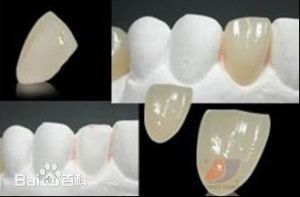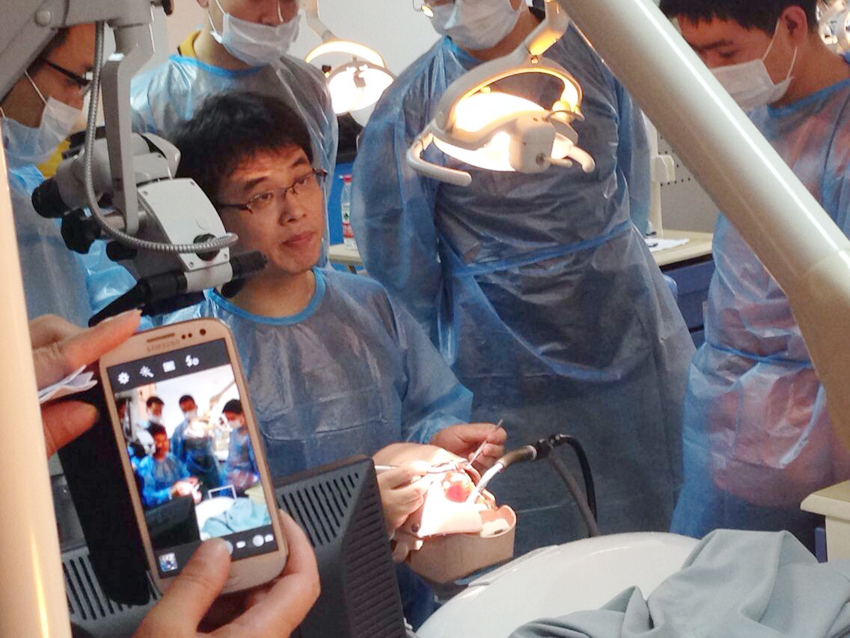
Porcelain veneer beauty repair production process
- Categories:Marketing Activities
- Author:
- Origin:
- Time of issue:2014-08-14
- Views:0
(Summary description)Porcelain veneer is natural and beautiful because of its color and lustre, which is unchanging for a long time and has good abrasion resistance.
Porcelain veneer beauty repair production process
(Summary description)Porcelain veneer is natural and beautiful because of its color and lustre, which is unchanging for a long time and has good abrasion resistance.
- Categories:Marketing Activities
- Author:
- Origin:
- Time of issue:2014-08-14
- Views:0
Porcelain veneer is an ideal veneer repair because of its natural and beautiful color, constant durability, good abrasion resistance, and good tissue compatibility. Porcelain veneer has a good effect on whitening repair. On July 17th, Dr. Wang Yiyong gave a detailed introduction to clinical dentists on the production process of porcelain veneer cosmetic repair at the Dental Medicine Training Center of Tongji University South Campus. Toboom provides product support for the dental preparation part of the lecture topic, and allows students to personally experience the performance advantages of the product during the teaching and trial process.


The following will share with you the methods and steps of making porcelain veneers:
1. Check the diagnosis, select the appropriate indications, and develop a treatment plan.
2. Dental preparation of the affected tooth
The columnar emery bur removes about 0.5mm of the enamel on the labial side, mainly removing the over-convex part, minimizing the protrusion of the lip, and appropriately reducing the protrusion of the neck. The neck of the lip is slightly shallow and deep. 0.3mm to assist retention. The mesial and far edges are abraded to reach the contact area, leaving the contact points, and the adjacency relationship cannot be destroyed, and the edges can also be slightly grooved. The advantage of the groove shape is that the boundary is clear, easy to place, easy to keep the veneer position stable, and the increase in the thickness of the edge position can also improve the edge strength. The cutting edge is abraded to reach the incisal edge, and the position of the incisal edge is preserved as much as possible to avoid direct contact between the incisal edge of the porcelain surface and the opposite tooth.

3. Impressions, models, color comparison
Take the impression of silicone rubber or elastic impression material, directly fill the working model with high-temperature substitute materials, or fill the working model with super anhydrite, and then use the working model to copy the high-temperature substitute. The method of color comparison is similar to that of porcelain crown restoration, but the special materials for porcelain veneer have only 6 colors to choose from (Japanese Matsukaze porcelain veneer materials), namely A1, A2, A3, A3.5, B2, D3. The color of the patient should be considered when comparing the color. The color after restoration and the color of the remaining real teeth should not be too different, otherwise it will affect the appearance. Patients often hate their discolored teeth, and instead hope to replace them with a very white one, so they choose the color to A1. But if the color of the remaining teeth is too dark, the contrast will be obvious, but it will be unreal and the aesthetic effect will be poor. Doctors should pay attention to the special psychology of patients with discolored teeth, patiently induce them, and try their best to make the selected color and real teeth naturally coordinate.
4. Porcelain veneer production
(1) Pretreatment of high-temperature model material generation: to remove the ammonia in the model material.
(2) Immersion of the model in water: Dip the model in distilled water until it is saturated. After taking it out, it can be coated with porcelain.
(3) Porcelain coating and sintering: Layered porcelain coating. First, apply the special base porcelain for veneer (opaque porcelain) and sinter it in a porcelain furnace; then apply body porcelain (body porcelain, neck porcelain and cut porcelain at one time), and then sinter again. Because the veneer is very thin, the overall thickness is only 0.5-0.7mm, the porcelain must be painted uniformly, and the operation is very difficult, so you must be very careful. After sintering, the shape can be slightly polished and trimmed, and finally glaze is applied, and then it is sintered in the furnace. The sintering conditions of base porcelain, body porcelain and glazing are different and should be preset according to material requirements.
(4) Remove the substitute material and take off the veneer.
Five. Oral test
When trying to lift, observe whether the neck edge and the near and far adjacent edges are suitable. If there is any discomfort, it can be modified appropriately. The color and lip shape cannot be modified because the generation type has been destroyed.

6. Porcelain veneer bonding
Etch the tooth surface with 37% phosphoric acid for 1-2 minutes. After sandblasting and ultrasonic cleaning, the bonding surface of the porcelain veneer is etched with 5% hydrofluoric acid for 5-10 minutes. After washing and drying, the porcelain surface is pasted with a light-curing composite resin, one by one. Put the composite resin on the surface of the tooth in a thin layer, place the porcelain veneer and press it slightly to make the porcelain veneer adhere to the tooth surface. The extruded composite resin is removed with a carving knife and cured under light for 40-60 seconds. It can also be bonded with chemical curing resin (such as EM enamel adhesive, etc.). After pasting, carefully remove the resin extruded from the gingival margin and adjacent gaps.
7. Check the bite-lift relationship and adjust
Because the porcelain veneer is very thin and the porcelain is brittle, if the porcelain veneer is directly subjected to the bite force, it is easy to break the porcelain veneer. Therefore, the porcelain veneer should not exceed the true value during the restoration of the anterior tooth porcelain veneer. The incisal edge of the tooth, and the incisal edge of the porcelain veneer cannot be contacted when the lower front teeth are extended. If the crown of the affected tooth is short, the porcelain veneer must cover the incisal margin and the incisal margin of the porcelain veneer must be thickened, and the lower anterior teeth must be adjusted and raised so that the lingual and incisal margins of the upper anterior teeth are extended No contact. After the restoration is completed, it is necessary to check whether the porcelain veneer has early contact with the real teeth during the median elevation, lateral occlusion and extension occlusion, and eliminate all possible contact points that may constitute direct occlusal contact with the porcelain veneer.

The main purpose of porcelain veneer restoration is to restore the beauty of the teeth and face, and care must be taken to protect it when using it. If you take care of it, it will generally not fall off and will become a permanent restoration, but if used improperly, it will also cause the porcelain veneer to crack or fall off. Therefore, when the restoration is completed, it is necessary to take care that the patient cannot use porcelain veneers to restore the tooth gnawing hard objects. The main manifestation of the failure of the porcelain veneer repair is cracking or shedding, and the clinical report has a very low shedding rate.
Scan the QR code to read on your phone

Page Copyright ©2021All Rights Reserved.Shanghai TOBOOM Technology Co., Ltd Powered by www.300.cn 沪ICP备2020028574号-1

Scan





